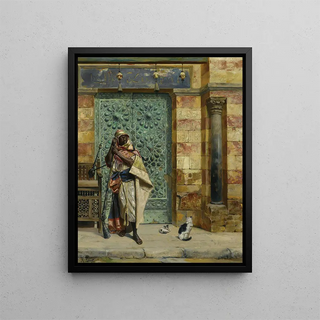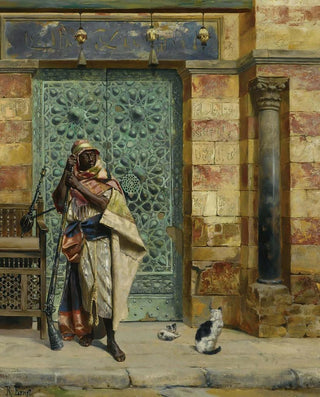Art print | The Nubian Guard - Rudolf Ernst


View from behind

Frame (optional)
In the vast panorama of art history, certain works stand out for their ability to capture the collective imagination. "The Nubian Guard" by Rudolf Ernst is a perfect example. This painting, imbued with an atmosphere that is both mystical and realistic, transports us to the heart of a fascinating era, where the East and West meet in a rich and complex visual dialogue. The scene depicted by Ernst evokes not only the beauty of human figures but also the cultural depth of the civilizations represented. Contemplating this piece, one feels invited to explore the stories hidden behind each gaze and gesture—a call to discover the history of the Nubians, guardians of an ancestral heritage.
Style and uniqueness of the work
Rudolf Ernst's style is characterized by striking realism, combined with an aesthetic sensitivity that transcends mere visual rendering. In "The Nubian Guard," mastery of light and shadow brings the characters to life, while vibrant colors evoke the warmth of African landscapes. The meticulous details of costumes, ornaments, and facial expressions testify to attentive observation of the world around him. Ernst manages to create an immersive atmosphere, where the viewer is invited to delve into the intimacy of the scene. Every element, whether it is the posture of the guards or the texture of fabrics, contributes to a richly visual storytelling. This work does not merely depict a frozen moment; it evokes a story, a culture, a world in its own right.
The artist and his influence
Rudolf Ernst, born in 1854 in Vienna, was an artist whose career was marked by an unceasing quest for exoticism and beauty. Trained in European art schools, he quickly turned to oriental themes, attracted by cultural diversity and distant landscapes. His work reflects an era when Orientalism fascinated the West—a artistic trend that influenced many contemporary artists. Ernst distinguished himself by his ability to marry impeccable technique with poetic sensitivity, creating works that continue to amaze and inspire. The representation

Matte finish

View from behind

Frame (optional)
In the vast panorama of art history, certain works stand out for their ability to capture the collective imagination. "The Nubian Guard" by Rudolf Ernst is a perfect example. This painting, imbued with an atmosphere that is both mystical and realistic, transports us to the heart of a fascinating era, where the East and West meet in a rich and complex visual dialogue. The scene depicted by Ernst evokes not only the beauty of human figures but also the cultural depth of the civilizations represented. Contemplating this piece, one feels invited to explore the stories hidden behind each gaze and gesture—a call to discover the history of the Nubians, guardians of an ancestral heritage.
Style and uniqueness of the work
Rudolf Ernst's style is characterized by striking realism, combined with an aesthetic sensitivity that transcends mere visual rendering. In "The Nubian Guard," mastery of light and shadow brings the characters to life, while vibrant colors evoke the warmth of African landscapes. The meticulous details of costumes, ornaments, and facial expressions testify to attentive observation of the world around him. Ernst manages to create an immersive atmosphere, where the viewer is invited to delve into the intimacy of the scene. Every element, whether it is the posture of the guards or the texture of fabrics, contributes to a richly visual storytelling. This work does not merely depict a frozen moment; it evokes a story, a culture, a world in its own right.
The artist and his influence
Rudolf Ernst, born in 1854 in Vienna, was an artist whose career was marked by an unceasing quest for exoticism and beauty. Trained in European art schools, he quickly turned to oriental themes, attracted by cultural diversity and distant landscapes. His work reflects an era when Orientalism fascinated the West—a artistic trend that influenced many contemporary artists. Ernst distinguished himself by his ability to marry impeccable technique with poetic sensitivity, creating works that continue to amaze and inspire. The representation






